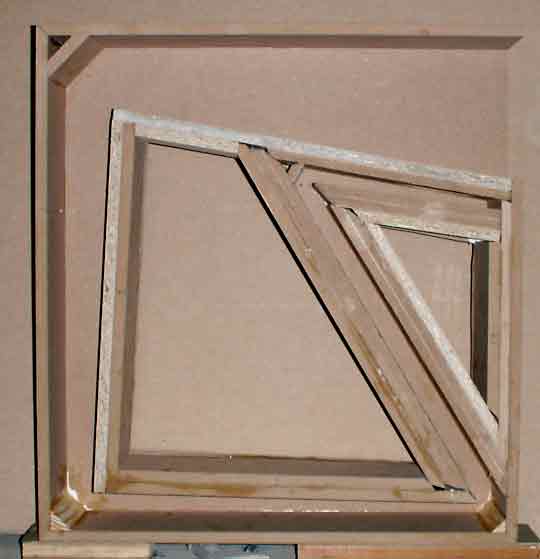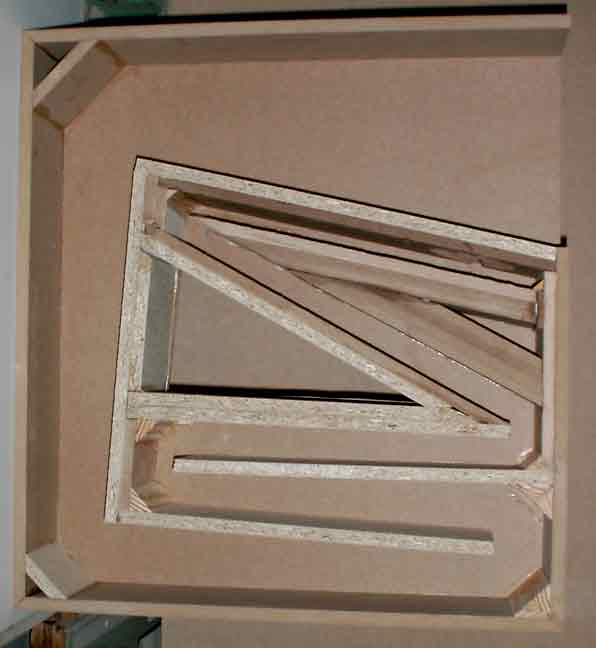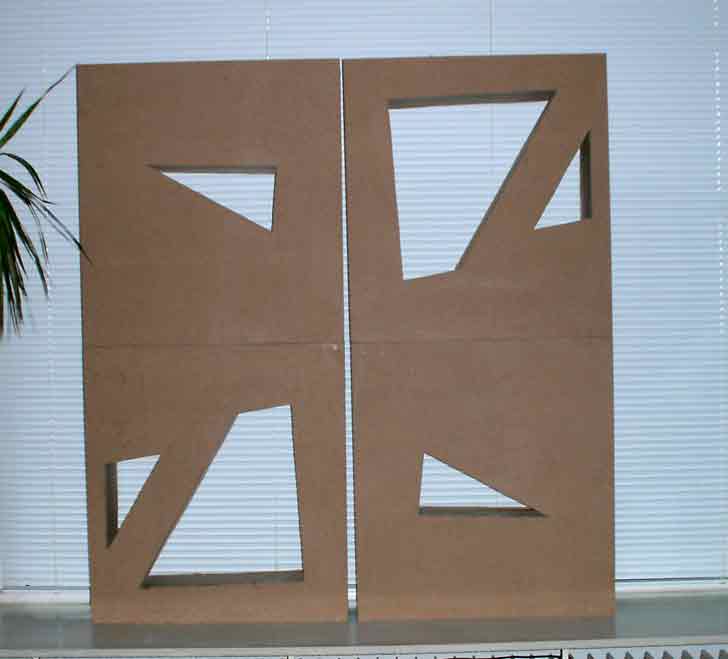Danley sound labs is introducing a new tapped horn called
TH-SPUD
I think this is an interesting concept and so I tried to model a diy version.
I'm thinking of using two B&C 8NDL51 drivers. They have a 7 mm xmax which I think should be enough for my small living room.
Planned layout +/- 120 x120 x 25cm:

Respons graph in Akabak with quarter wave resonating tube at 65Hz and 60Hz low pass:

Hornresponse input:

So what do you think? Will it work? Any design faults?
TH-SPUD
I think this is an interesting concept and so I tried to model a diy version.
I'm thinking of using two B&C 8NDL51 drivers. They have a 7 mm xmax which I think should be enough for my small living room.
Planned layout +/- 120 x120 x 25cm:

Respons graph in Akabak with quarter wave resonating tube at 65Hz and 60Hz low pass:

Hornresponse input:

So what do you think? Will it work? Any design faults?
I didnt sim it, but 7mm xmax sounds really low for this low tuning. Check at what input power it runs out of excursion.
Yes the power handling of this is not so high.
It runs out of xmax at only 12V rms

This should give around 118dB max with corner placement.
Would this be enough or should I better be looking for a more high excursion car audio driver? How would these car drivers compare on a distortion level against the PA driver I'm using now?
It runs out of xmax at only 12V rms

This should give around 118dB max with corner placement.
Would this be enough or should I better be looking for a more high excursion car audio driver? How would these car drivers compare on a distortion level against the PA driver I'm using now?
In a tapped horn the phase varies wildly across the passband and above. Using enclosures with different tuning is strongly not recommended, it results in bad summing or cancellation. Phase matching a mid/bass system and a tapped horn is already difficult enough.
Hello,
did you read my double horns? :
SAXOPHON, TROMBONE, POSAUNE,
KORNETT and SUB FANFARE,
special the measurements,
best read "about what" in the middle:
http://www.hm-moreart.de/11.htm
did you read my double horns? :
SAXOPHON, TROMBONE, POSAUNE,
KORNETT and SUB FANFARE,
special the measurements,
best read "about what" in the middle:
http://www.hm-moreart.de/11.htm
G'day geitmans
The Tang Band W8-740 looks great in a box like this. 12mm X-max helps out the power situation quite a bit, too.
Cheers
William Cowan
The Tang Band W8-740 looks great in a box like this. 12mm X-max helps out the power situation quite a bit, too.
Cheers
William Cowan
An interesting driver for a low profile box:
http://www.parts-express.com/pe/pshowdetl.cfm?&DID=7&Partnumber=264-838&ctab=2#Tabs
In an 18hz TH a series pair will be 96dB (at 20hz) in 2Pi and take 40V without exceeding x-max. Average about 118dB/40V, ±2dB from 18hz~60hz.
Of course room gain or 1Pi loading would add to this.
http://www.parts-express.com/pe/pshowdetl.cfm?&DID=7&Partnumber=264-838&ctab=2#Tabs
In an 18hz TH a series pair will be 96dB (at 20hz) in 2Pi and take 40V without exceeding x-max. Average about 118dB/40V, ±2dB from 18hz~60hz.
Of course room gain or 1Pi loading would add to this.
AkAbak and Hornresp are what is generally used here.
Hornresp is easier to learn.
http://www.diyaudio.com/forums/showthread.php?threadid=119854
Hornresp is easier to learn.
http://www.diyaudio.com/forums/showthread.php?threadid=119854
the W8-740P indeed looks like a good alternative. Its cheaper and has a higher Xmax. I will try to model it.
I tried to model the mechanical behaviour of the cabinet if I would build it with OSB. The first renonance occurs at around 103 Hz. The weakest part is as expected around the mouth of the horn.

But 103Hz seems quite low to me. I don't know if anyone has a rule of thumb of how much the first renonance of the cabinet and the maximum operating frequency should be separated?
Maybe it is better to build it using birch plywood. When I find some good mechanical data for plywood I will try to model the effect of it.
I tried to model the mechanical behaviour of the cabinet if I would build it with OSB. The first renonance occurs at around 103 Hz. The weakest part is as expected around the mouth of the horn.

But 103Hz seems quite low to me. I don't know if anyone has a rule of thumb of how much the first renonance of the cabinet and the maximum operating frequency should be separated?
Maybe it is better to build it using birch plywood. When I find some good mechanical data for plywood I will try to model the effect of it.
I've never seen solid modeling software like that. I don't understand exactly what I'm looking at, but it looks cool!
Also, why are you using OSB? I'm assuming you're actually referring to MDF, which has a much higher density and is preferred over all other types of cabinet material.
Nice work!!
C
Also, why are you using OSB? I'm assuming you're actually referring to MDF, which has a much higher density and is preferred over all other types of cabinet material.
Nice work!!
C
OSB is about the same strength as MDF, weighs less, and glues up better. If anything it is slightly better than mdf as far as strength goes. BB Plywood is the best though.
Any design faults?
IMO, I fully agree with Eva:
‘In a tapped horn the phase varies wildly across the passband and above.’
See the bad phase response in picture: 2(7)
It runs out of xmax at only 12 V rms
No, earlier and even if you intend to use this design with most ordinary commercial bass-amps that often uses a 12 dB HP filters at 20 Hz for subsonic frequency protection. See picture 1(7)
This should give around 118 dB max with corner placement.
Yes, but only if you count the SPL above 60-70 Hz Hz. See picture 3(7)
IMO a better use of the 8NDL51 drivers for Tapped Horns: See the pictures 4(7) – 5(7) and if SQ is the most important goal: See the smaller BP-TQWT in pictures 6(7)-7(7).
b
1(7)
Attachments
- Status
- Not open for further replies.
- Home
- Loudspeakers
- Subwoofers
- Dual 8" tapped horn = TH-SPUD









